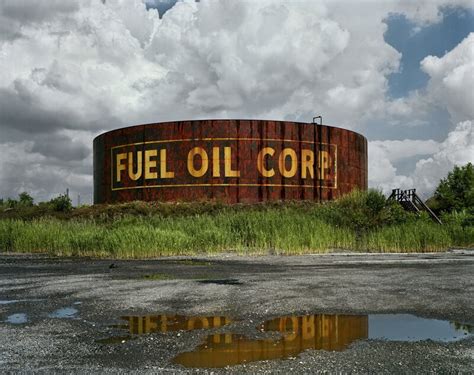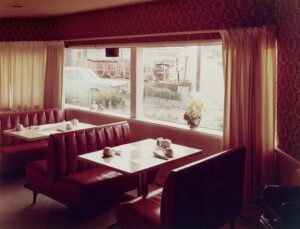Andrew Moore’s Fuel Oil (2008) is a compelling photograph that encapsulates the essence of industrial decline and urban transformation. Through his lens, Moore captures the remnants of a once-thriving industrial site in Detroit, a city deeply affected by the forces of deindustrialization. This large-format image serves not only as a historical record but also as a commentary on the socio-economic changes that have reshaped America’s urban landscapes.
Moore, an American photographer born in 1957, is widely celebrated for his ability to document the intersection of history, culture, and the built environment. His work often explores places in transition, from the abandoned factories of the Rust Belt to the crumbling grandeur of Havana. Fuel Oil is a prime example of his visual storytelling, where a single image speaks volumes about the past, present, and uncertain future of the spaces he documents.
The Subject Matter: Industrial Decline in Detroit
The subject of Fuel Oil is a dilapidated industrial building in Detroit, with the words “Fuel Oil” faintly visible on its weathered facade. This structure, now a relic of a bygone era, once served as part of the city’s extensive industrial network. Detroit, once a booming manufacturing hub, has experienced significant economic downturns due to the decline of the American automotive industry and broader shifts in global trade.
The presence of the words “Fuel Oil” in the photograph evokes thoughts of an era when industries thrived, workers were plentiful, and the economy relied heavily on manufacturing. However, the faded and peeling paint suggests the inevitable passage of time and the abandonment of such industries. The composition of the photograph—where the building appears small in comparison to the vast, open sky—further emphasizes its isolation and the emptiness that now pervades these once-bustling industrial spaces.
Detroit’s economic decline, which began in the latter half of the 20th century, was exacerbated by factors such as outsourcing, automation, and white flight. Entire neighborhoods were left abandoned, and buildings that once symbolized economic prosperity became ghostly reminders of a different era. Moore’s Fuel Oil documents this transformation with a sense of quiet reverence, allowing the viewer to engage with the history embedded in the image.
Composition and Aesthetic Choices
Moore’s approach to photography is meticulous and deliberate, often utilizing large-format cameras to capture an extraordinary level of detail. In Fuel Oil, his composition is both simple and powerful. The building itself is slightly off-center, allowing the expansive sky to dominate much of the frame. This visual choice creates a sense of space, emptiness, and loneliness—qualities that are often associated with abandoned industrial sites.
The use of natural lighting in the photograph adds another layer of depth. The muted tones of the decaying structure contrast with the brighter hues of the sky, subtly drawing the viewer’s attention to the passage of time. The theme of backdrops and highlights further enhances the textures of the building’s facade, emphasizing its deterioration.
Moore’s ability to capture color and detail is evident in this image. Unlike some photographers who opt for black and white to highlight urban decay, Moore’s use of color adds richness to the scene. The faded reds and browns of rusted metal, the chipped paint, and the weathered wood all contribute to a narrative of decline. This color palette evokes a sense of nostalgia, as if the photograph is inviting viewers to recall the building’s past and imagine its former vitality.
Themes of Urban Decay and Transformation
One of the central themes of Fuel Oil is urban decay—a subject Moore has explored extensively throughout his career. The decline of American industrial cities like Detroit has been well-documented in photography, literature, and film, but Moore’s approach is distinct in its emphasis on architectural beauty and historical resonance. Rather than portraying decay as purely negative, he captures its haunting elegance, drawing attention to the layers of history present in these structures.
Beyond decay, Fuel Oil also reflects themes of transformation. While the building itself is in ruins, its presence in the photograph suggests the potential for rebirth or repurposing. Many of Detroit’s abandoned structures have been reimagined as art spaces, community centers, or sites of urban farming. Moore’s work does not dictate a singular interpretation but instead encourages viewers to consider the evolving nature of these spaces.
The theme of impermanence is also central to the image. Cities are living entities that grow, change, and sometimes decline. Buildings that once represented economic success can become obsolete, yet they remain as markers of history. Fuel Oil captures this moment of transition, where the past is still visible but the future remains uncertain.
Moore’s Approach to Storytelling
Andrew Moore’s work is deeply rooted in storytelling, and Fuel Oil exemplifies his ability to convey complex narratives through a single frame. He does not stage his images or manipulate them to fit a specific narrative; rather, he finds beauty and significance in real-world spaces as they exist. His choice of subjects often involves places with rich histories—whether it be an abandoned theater, a decaying factory, or a derelict home.
Moore’s photographic process is patient and immersive. He spends significant time exploring locations, understanding their histories, and considering the best way to frame them. This careful approach is evident in Fuel Oil, where every detail—the position of the building, the lighting, the weathering of the materials—feels intentional.
His work aligns with a broader tradition of documentary photography that seeks to capture the realities of societal change. Photographers such as Walker Evans and Dorothea Lange documented the economic hardships of the Great Depression, while later artists like Camilo José Vergara focused on urban decline in American cities. Moore continues this lineage but adds his own distinct perspective by emphasizing the aesthetic and emotional impact of these environments.
Legacy and Impact
Andrew Moore’s photographs are widely respected in the art world and have been acquired by major institutions such as the Whitney Museum of American Art, the Museum of Modern Art, and the Los Angeles County Museum of Art. His work has also been published in several books, including Detroit Disassembled, which explores the city’s post-industrial landscape.
Fuel Oil is not just a photograph of an abandoned building—it is a meditation on time, change, and resilience. It invites viewers to reflect on the broader implications of industrial decline and consider the future of cities like Detroit. While some may see decay as a symbol of failure, Moore’s work encourages a more nuanced perspective, one that acknowledges both loss and possibility.
Andrew Moore’s Fuel Oil (2008) is a striking example of how photography can serve as both documentation and art. Through his careful composition, masterful use of color, and deep engagement with history, Moore transforms an abandoned industrial building into a powerful symbol of urban transformation. The photograph speaks to the rise and fall of industry, the impact of economic shifts on communities, and the ongoing dialogue between past and present.
As cities continue to evolve, images like Fuel Oil remain essential reminders of where we have been and where we might be headed. Moore’s work ensures that these spaces—and the stories they hold—are not forgotten, but rather preserved through the lens of art and history.
No comments yet.








